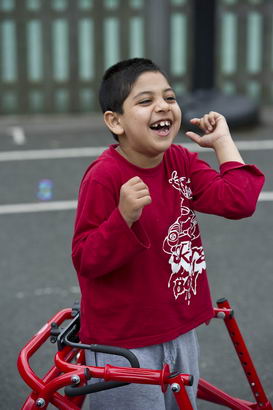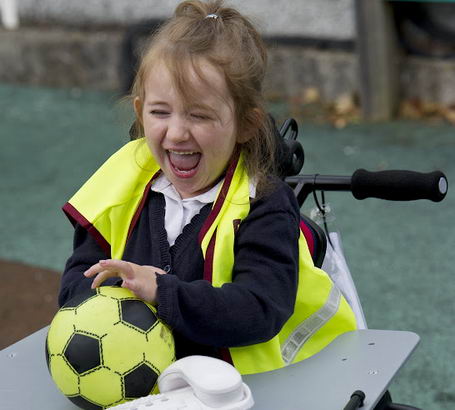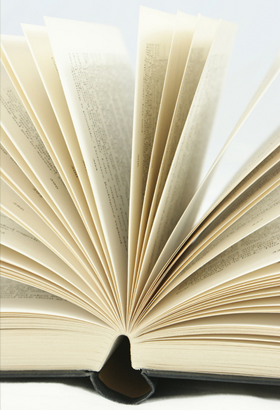
All children have a right to play. The United Nations Convention on the Rights of the Child (article 31) states: 'Parties recognize the right of the child to rest and leisure, to engage in play and recreational activities appropriate to the age of the child and to participate freely in cultural life and the arts.'
Play is difficult to define, but includes the following characteristics. It is:
- Not reliant on materials, activities or contexts;
- Internally motivated;
- Voluntary;
- Focused on the process rather than an end product;
- Flexible and spontaneous;
- Free from the constraints of reality;
- Pleasurable.
During play, the child is in control, and actively engaged in the play.
(Luckett et al, 2007)

One of the most depressing statements to my ears, is the assertion that a child is too disabled to play.
Here the focus is on the child's inability to manipulate toys when alone or in the company of other children. However this
incapacity is just as true of babies and yet we would not dream of saying they can't play. Indeed adults make strenuous efforts
to get babies playing and their reward at first is simple – the baby's smile.
McConkey, 2006
... a comprehensive understanding of play should include detailed information about how play typically
develops in young children and eventually results in these more advanced levels of play...
Despite the current emphasis on promoting the systematic, evidence based use-of-play... efforts remain problematic because
of the continued use of global descriptions of play, inattention to identifying developmental progress, and confounding interventions
in play per se with the use of play as an activity base with other domains.
Lifter et al, 2011
...the most effective behavioural interventions have been those which have built on children's existing
abilities or have relied on the motivating nature of activities themselves rather than on external rewards.
Luckett et al, 2007

The Social Play Record offers systematic assessment and targeted intervention for children who experience
difficulty with social interaction. It supports development and social inclusion by enhancing the understanding, knowledge
and skills of families, children, practitioners and peers. The SPR is a flexible tool.
It spans development from early infancy to adolescence, providing an ongoing record of social play. It can be introduced at
any age or stage within this developmental range. It is applicable for children of all abilities in any educational or social
setting.
White, 2006
For a list of play assessments read Lifter et al (2011).
Lifter and Bloom's (1989; Lifter, 2000) Developmental Play Assessment focuses on cognitive aspects of play, and identifies mastered, emerging and unlearned skills. Assessment is based on periodic 30-minute video play samples and a developmental sequence of categories.
Analysis has precise criteria, but broadly includes:
- Determining the frequency of different play activities;
- Allocating the activities into developmental categories of play, which gives the frequency and variety of activities within the category:
- Categories mastered: reasonable frequency and variety of examples.
- Categories associated with next developmental stage which are emerging: occur infrequently.
- Categories as yet unlearned: not represented in
play sample.

Analyse the literature on play and children with SLD/PMLD/CLDD, including approaches such as Intensive interaction, Integrated play groups, Floor time model, etc.
Write a position paper for your school on play including principles, key approaches and outcomes
from play.

Barton, E.E. (2010) Development of a taxonomy of pretend play for children with disabilities, Infants and Young Children, 23 (4), 247–261.
Lifter, K. (2000) Linking assessment to intervention for children with developmental disabilities or at-risk for developmental delay: The developmental play assessment (DPA) instrument. In: K. Gitlin-Weiner, A. Sandgrund and C. Schafer (eds) Play Diagnosis and Assessment (2nd edn). New York: John Wiley.
Lifter, K. and Bloom, L. (1989) Object play and the emergence of language, Infant Behavior and Development, 12, 395-423.

Lifter, K., Foster-Sanda, S., Arzamarski, C., Briesch, J. and McClure, E. (2011) Overview of play: its uses and importance in early intervention/early childhood special education, Infants & Young Children, 24 (3), 225–245.
Luckett, T., Bundy, A. and Roberts, J. (2007) Do behavioural approaches teach children with autism to play or are they pretending?, Autism, 11 (4), 365-388.
McConkey, R. (2006) Realising the potential of play for ALL children, PMLD-Link, 18 (3), 8-10.
Santer, J., Griffiths, C. and Goodall, D. (2007) Free Play in Early Childhood: A literature review. National Children's Bureau.
White, C. (2006) The Social Play Record. London: Jessica Kingsley.